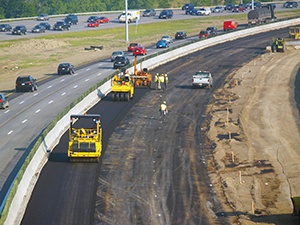 National Work Zone Awareness Week (NWZAW) is upon us. This year’s theme is Work Zone Safety: Everybody’s Responsibility. With warmer weather comes roadwork season. As we hit the road, it is important we are aware and alert while driving in work zones. This protects workers and ourselves.
National Work Zone Awareness Week (NWZAW) is upon us. This year’s theme is Work Zone Safety: Everybody’s Responsibility. With warmer weather comes roadwork season. As we hit the road, it is important we are aware and alert while driving in work zones. This protects workers and ourselves.
While many work zone safety campaigns are aimed at protecting workers, motorist are also at risk for being injured or killed. In 2016, fatal crashes and fatalities in work zones exceeded the previous three-year average with 683 fatal crashes, 765 fatalities. More than half of those fatalities were motorist. While driving in a work zone, actively practice these simple safety tips to keep you and others safe:
- Stay alert and minimize distractions
- Keep your headlights on
- Pay attention to road signs and watch the brake lights of traffic
- Merge into the proper lane
- Don’t tailgate
- Obey the posted speed limit
- Resist changing lanes unless necessary
- Follow instructions from flaggers
- Expect the unexpected
- Be patient
Each year, more than 100 construction workers are killed and over 20,000 are injured. When minimizing traffic collisions in work zones, worker injuries are minimized. However, fatality data indicates that workers being struck by a motorist in a work zone account for only half the vehicle-related fatalities among highway workers. The other half are caused by: runovers/backovers by dump trucks, collisions between vehicles, and being caught between/struck by equipment or objects. The following tips will help keep workers safe in work zones:
- Develop and implement a traffic control plan to direct motorists around work zones, allowing sufficient time and advance notice for merges and lane changes.
- Use clear signage, signals, and message boards to communicate instructions to drivers traveling near work zones.
- Provide high-visibility clothing and hard hats to flaggers, and make sure they stand in a safe, well-lighted location where they can be easily seen by motorists.
- Whenever possible, use physical barriers to separate workers from traffic.
- Consider using alternative traffic management systems instead of flaggers, such as portable traffic signals or remote signaling devices, particularly in hazardous conditions like inclement weather, night work, and high traffic speeds.
- Refer to the Manual on Uniform Traffic Control Devices (MUTCD) for standards on traffic control devices, signs, flagging garments, barricades, and other protective measures for workers in road construction zones. OSHA has incorporated the MUTCD by reference into its construction standards for signs, signals, and barricades, found at 29 CFR 1926.200-203.
- Establish safe routes for workers traveling on foot, both within the work zone to protect them from construction vehicles and equipment, and in and out of the work zone to protect them from traffic hazards.
- Train all workers in highway construction zones on the hazards they are exposed to and applicable safe work practices. This should include:
- Specific training for flaggers on signaling methods.
- Training for all workers on construction vehicle routes, visibility limits, and blind spots.
- Training for equipment operators and signal persons on hand signals used on the worksite.
- Training for all workers in the ways shiftwork and night work may affect their performance.



